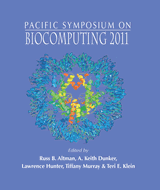Comparing Bacterial Communities Inferred from 16s Rrna Gene Sequencing and Shotgun Metagenomics
Neethu Shah1, Haixu Tang1, Thomas G. Doak2, Yuzhen Ye1
1: School Of Informatics and Computing, 2: Biology Department, Indiana University Bloomington, IN 47408, U.S.A
Email: neetshahf{hatang, tdoak, yyeg}@indiana.edu
Pacific Symposium on Biocomputing 16:165-176(2011)

Abstract
16S rRNA gene sequencing has been widely used for probing the species structure of a variety of environmental bacterial communities. Alternatively, 16S rRNA gene fragments can be retrieved from shotgun metagenomic sequences (metagenomes) and used for species pro ling. Both approaches have their limitations|16S rRNA sequencing may be biased because of unequal ampli cation of species' 16S rRNA genes, whereas shotgun metagenomic sequencing may not be deep enough to detect the 16S rRNA genes of rare species in a community. However, previous studies showed that these two approaches give largely similar species pro les for a few bacterial communities. To investigate this problem in greater detail, we conducted a systematic comparison of these two approaches. We developed PHYLOSHOP, a pipeline that predicts 16S rRNA gene fragments in metagenomes, reports the taxonomic assignment of these fragments, and visualizes their taxonomy distribution. Using PHYLOSHOP, we analyzed 33 metagenomic datasets of human-associated bacterial communities, and compared the bacterial community structures derived from these metagenomic datasets with the community structure derived from 16S rRNA gene sequencing (71 datasets). Based on several statistical tests (including a statistical test proposed here that takes into consideration di erences in sample size), we observed that these two approaches give signi cantly di erent community structures for nearly all the bacterial communities collected from di erent locations on and in human body, and that these di erences cannot be be explained by di erences in sample size and are likely to be attributed by experimental method.
[Full-Text PDF] [PSB Home Page]